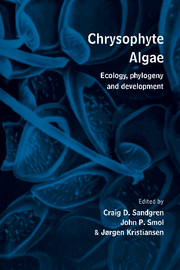Book contents
- Frontmatter
- Contents
- Preface
- List of contributors
- 1 History of chrysophyte research: origin and development of concepts and ideas
- Part I Phylogeny, systematics and evolution
- Part II Development, physiology and nutrition
- 5 Comparative aspects of chrysophyte nutrition with emphasis on carbon, phosphorus and nitrogen
- 6 Mixotrophy in chrysophytes
- 7 Biomineralization and scale production in the Chrysophyta
- 8 Immunological and ultrastructural studies of scale development and deployment in Mallomonas and Apedinella
- Part III Ecology, paleoecology and reproduction
- Part IV Contributed original papers
- Index of scientific names
- Subject index
6 - Mixotrophy in chrysophytes
Published online by Cambridge University Press: 05 March 2012
- Frontmatter
- Contents
- Preface
- List of contributors
- 1 History of chrysophyte research: origin and development of concepts and ideas
- Part I Phylogeny, systematics and evolution
- Part II Development, physiology and nutrition
- 5 Comparative aspects of chrysophyte nutrition with emphasis on carbon, phosphorus and nitrogen
- 6 Mixotrophy in chrysophytes
- 7 Biomineralization and scale production in the Chrysophyta
- 8 Immunological and ultrastructural studies of scale development and deployment in Mallomonas and Apedinella
- Part III Ecology, paleoecology and reproduction
- Part IV Contributed original papers
- Index of scientific names
- Subject index
Summary
Microbial food web
Within the past decade there have been significant changes in the perception of the interactions among trophic levels in aquatic environments. The once-traditional phytoplankton-macrozooplankton-fish food web concepts have been revised to more fully accommodate the effects of both prokaryotes and nutritionally diverse protists. For instance, about 40-60% of the carbon fixed by all phytoplankton is thought to pass through the heterotrophic bacterial community (Cole et al. 1988) rather than into zooplankton directly. Furthermore, oligotrophic marine and freshwaters are now characterized by the preponderance of an assemblage of small phytoplankton less than 2 urn in diameter called picoplankton. This assemblage is composed primarily of chroococcoid cyanobacteria such as Synechococcus and Chlorella-like eukaryotes, both of which contribute significantly to overall primary production (Platt et al 1983; Stockner & Antia 1986; Stockner 1988). Because these tiny cells are poorly grazed by macrozooplankton, they contribute little to the traditional food web.
Much of this bacterial and picoplanktonic carbon is transferred to higher trophic levels via diverse protozoa. In a series of seminal papers (Fenchel 1982a, b, c, d), small flagellates < 20 μm in diameter were reported to be efficient bacterivores with relatively high particle ingestion rates. Given the observed densities of these small protozoa in natural systems together with the calculated grazing rates, Fenchel concluded that such protozoa could have a significant impact on natural bacterial abundances.
- Type
- Chapter
- Information
- Chrysophyte AlgaeEcology, Phylogeny and Development, pp. 119 - 140Publisher: Cambridge University PressPrint publication year: 1995
- 32
- Cited by



